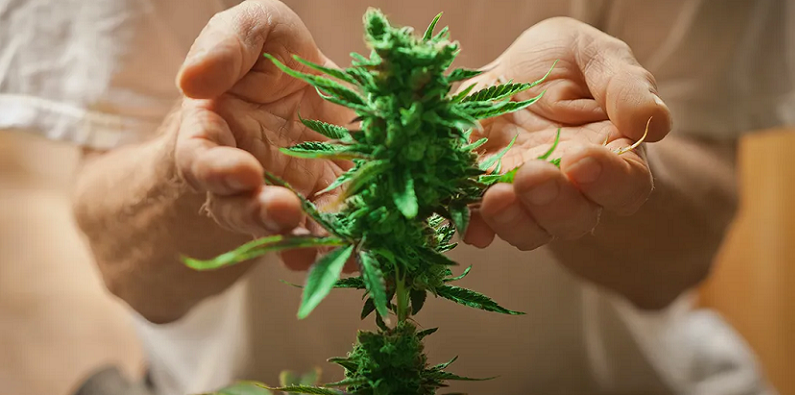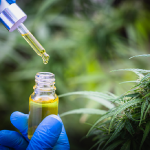Chronic pain affects millions of people worldwide, making daily life a constant struggle. Traditional pain management methods, often reliant on prescription medications, can lead to dependency and a range of side effects. As people search for safer and more effective alternatives, CBD and cannabis have emerged as promising solutions. Here we explore the benefits of CBD and cannabis for pain management, providing insights into their mechanisms and clinical evidence.
Contents
- Understanding CBD and Cannabis
- CBD and THC Mechanisms of Pain Relief
- Clinical Evidence and Research Involving CBD, THC, and Pain Management
- Benefits of Using CBD and Cannabis for Pain Management
- References
Understanding CBD and Cannabis
To fully appreciate the benefits of CBD and cannabis for pain management, it’s essential to understand what these substances are and how they function.
What Is CBD?
CBD, short for cannabidiol, is one of the many chemical compounds found in the cannabis plant. Unlike THC, the psychoactive component of cannabis, CBD is non-psychoactive, meaning it doesn’t produce a “high.” This characteristic makes CBD an attractive option for those seeking relief from pain and other symptoms without the mind-altering effects of marijuana.
Definition and Chemical Composition
CBD is a cannabinoid, a type of chemical compound that interacts with the body’s endocannabinoid system. It is typically extracted from hemp, a variety of cannabis with low THC levels. The chemical structure of CBD includes 21 carbon atoms, 30 hydrogen atoms, and 2 oxygen atoms.
Extraction Sources (Hemp vs. Marijuana)
CBD can be extracted from both hemp and marijuana plants. Hemp-derived CBD contains less than 0.3% THC, making it legal in many regions and preferred for its non-psychoactive properties. Marijuana-derived CBD, on the other hand, may contain higher THC levels, which can result in psychoactive effects.
What Is Cannabis?
Cannabis is a plant genus that includes several species, most notably Cannabis sativa and Cannabis indica. The plant is known for its psychoactive properties due to the presence of THC, as well as its medicinal benefits provided by both THC and CBD.
Definition and Chemical Composition
Cannabis contains over 100 cannabinoids, with THC and CBD being the most well-known. THC is responsible for the psychoactive effects, while CBD offers therapeutic benefits without causing a high. The plant also contains terpenes and flavonoids, which contribute to its aroma, flavor, and potential therapeutic effects.
Different Strains and Their Uses
Cannabis is typically categorized into different strains, each with unique characteristics and potential uses. Sativa strains are often associated with uplifting and energizing effects, making them suitable for daytime use. Indica strains are known for their relaxing and sedative properties, making them ideal for nighttime use. Hybrid strains combine elements of both sativa and indica, offering a balance of effects [1].
Distinguishing Between CBD and THC
Understanding the differences between CBD and THC is crucial for comprehending their distinct effects and benefits.
Psychoactive vs. Non-Psychoactive Properties
THC is the primary psychoactive compound in cannabis, responsible for the “high” sensation. In contrast, CBD is non-psychoactive and does not alter the user’s state of mind. This difference makes CBD a preferred choice for those seeking therapeutic benefits without the psychoactive effects.
Legal Status and Regulations
The legal status of CBD and THC varies widely by region. CBD derived from hemp with less than 0.3% THC is legal in many places, while THC is still classified as a controlled substance in several areas. It’s important to be aware of local regulations when considering the use of CBD or cannabis for pain management.
CBD and THC Mechanisms of Pain Relief
Understanding how CBD and cannabis relieve pain involves examining their interaction with the body’s systems.
Interaction with the Endocannabinoid System
The endocannabinoid system (ECS) plays a crucial role in regulating various bodily functions, including pain perception. CBD and THC interact with this system to provide pain relief.
Overview of the Endocannabinoid System
The ECS consists of endocannabinoids, receptors, and enzymes. Endocannabinoids are natural compounds produced by the body, while receptors (CB1 and CB2) are found throughout the body, including the brain and immune cells. Enzymes break down endocannabinoids after they fulfill their function.
How CBD and THC Affect Pain Perception
CBD and THC influence the ECS by interacting with its receptors. THC binds directly to CB1 receptors, which are abundant in the brain and nervous system, reducing pain and producing psychoactive effects. CBD, on the other hand, does not bind directly to these receptors but influences them indirectly, enhancing the natural pain-relieving response of the ECS without causing a high [2].
Anti-Inflammatory Properties
Inflammation is a common cause of pain, and both CBD and THC have been shown to possess anti-inflammatory properties that can help alleviate pain.
CBD’s Role in Reducing Inflammation
CBD has been found to reduce inflammation by inhibiting the production of inflammatory cytokines and promoting the death of overactive immune cells. This action helps decrease the inflammation that contributes to pain in conditions such as arthritis and inflammatory bowel disease.
THC’s Role in Reducing Inflammation
THC also reduces inflammation, primarily through its interaction with CB2 receptors found in the immune system. By modulating immune responses, THC can help reduce inflammation and pain associated with various conditions, including multiple sclerosis and chronic inflammatory diseases.
Neurological Effects
CBD and THC also have direct effects on the nervous system, which contribute to their pain-relieving properties.
Modulation of Pain Signals
CBD and THC can modulate pain signals by interacting with neurotransmitters and pain receptors in the nervous system. This interaction can inhibit the transmission of pain signals to the brain, reducing the sensation of pain.
Impact on Chronic Pain Conditions
Chronic pain conditions, such as neuropathic pain, often involve dysfunction in the nervous system. CBD and THC have been shown to help manage chronic pain by restoring balance to the nervous system and reducing the hyperactivity of pain pathways [3].

Clinical Evidence and Research Involving CBD, THC, and Pain Management
The effectiveness of CBD and cannabis for pain management is supported by a growing body of clinical evidence and research.
Studies on CBD for Pain Management
Research into CBD’s potential for pain relief has produced promising results. Several studies have explored its efficacy in managing different types of pain.
Key Findings from Recent Research
Recent studies have shown that CBD can significantly reduce pain and improve the quality of life for patients with chronic pain conditions. For instance, a study published in the Journal of Pain Research found that CBD treatment resulted in a notable reduction in pain intensity and improved sleep quality in patients with chronic pain.
Effectiveness for Specific Pain Conditions (e.g., Arthritis, Neuropathic Pain)
CBD has demonstrated particular effectiveness in treating conditions like arthritis and neuropathic pain. Research published in the European Journal of Pain showed that topical CBD application reduced pain and inflammation in rats with arthritis. Similarly, a study in the Journal of Experimental Medicine found that CBD treatment significantly reduced neuropathic pain and inflammation in rodents.
Studies on Cannabis for Pain Management
Cannabis, containing both CBD and THC, has also been extensively studied for its pain-relieving properties. Research has focused on its efficacy for various pain conditions, especially those that are difficult to manage with conventional treatments.
Key Findings from Recent Research
Recent studies have validated the effectiveness of cannabis in pain management. A review published in the National Academies of Sciences, Engineering, and Medicine reported that there is substantial evidence that cannabis is effective in treating chronic pain in adults.
Effectiveness for Specific Pain Conditions (e.g., Cancer Pain, Fibromyalgia)
Cannabis has shown promise in treating pain associated with cancer and fibromyalgia. A study in the Journal of Pain and Symptom Management found that cannabis use led to significant pain reduction in cancer patients. Another study in the journal Pain Medicine reported that cannabis significantly improved pain, sleep quality, and overall quality of life in patients with fibromyalgia.
Comparative Analysis: CBD vs. THC in Pain Relief
Understanding the comparative benefits of CBD and THC is crucial for determining the most appropriate treatment for pain management.
Benefits and Limitations of Each
CBD and THC each offer unique benefits for pain relief. CBD is valued for its non-psychoactive properties and minimal side effects, making it suitable for those who want to avoid the high associated with THC. However, THC can provide more potent pain relief for severe pain conditions. The primary limitation of THC is its psychoactive effects, which may not be desirable for all users.
Synergistic Effects of Combined Use
When used together, CBD and THC can produce synergistic effects, enhancing pain relief. This phenomenon, known as the entourage effect, suggests that the combined use of cannabinoids may be more effective than using them individually. Studies have shown that patients often experience better pain management when using products that contain both CBD and THC [4].
Benefits of Using CBD and Cannabis for Pain Management
CBD and cannabis offer numerous advantages for pain management, making them attractive alternatives to traditional pain medications.
Non-Addictive Alternative to Opioids
One of the most significant benefits of CBD and cannabis is their potential to serve as non-addictive alternatives to opioids, which are commonly prescribed for pain but carry a high risk of addiction.
Opioid Crisis Overview
The opioid crisis has become a major public health issue, with millions of people affected by opioid addiction. Over-reliance on opioids for pain management has led to widespread abuse, overdose deaths, and a significant burden on healthcare systems.
Advantages of CBD and Cannabis Over Opioids
CBD and cannabis provide effective pain relief without the high risk of addiction associated with opioids. These substances interact with the body’s endocannabinoid system to reduce pain, offering a safer alternative for those in need of long-term pain management solutions. By reducing the reliance on opioids, CBD and cannabis can help mitigate the risks of addiction and overdose.
Minimal Side Effects
Another advantage of using CBD and cannabis for pain management is their relatively minimal side effects compared to traditional pain medications.
Common Side Effects of CBD and Cannabis
The side effects of CBD are generally mild and may include dry mouth, changes in appetite, and fatigue. Cannabis, particularly THC, can cause temporary psychoactive effects such as euphoria, altered perception, and impaired coordination. However, these effects are typically short-lived and manageable.
Comparison with Traditional Pain Medications
Traditional pain medications, such as opioids and nonsteroidal anti-inflammatory drugs (NSAIDs), can cause severe side effects and complications, including gastrointestinal issues, liver damage, and cardiovascular problems. In contrast, CBD and cannabis have a more favorable safety profile, making them a preferable option for many individuals seeking pain relief.
Improved Quality of Life
Using CBD and cannabis for pain management can lead to significant improvements in quality of life by enhancing daily functioning and providing psychological benefits.
Enhanced Daily Functioning
Chronic pain can severely impact an individual’s ability to perform daily activities and maintain an active lifestyle. By effectively reducing pain, CBD and cannabis can help individuals regain mobility and participate more fully in their daily routines, leading to an overall improvement in well-being.
Psychological Benefits (e.g., Reduced Anxiety and Depression)
Chronic pain often contributes to mental health issues such as anxiety and depression. CBD and cannabis have been shown to have anxiolytic and antidepressant effects, helping to alleviate these symptoms. By addressing both physical pain and psychological distress, these substances can offer a holistic approach to improving quality of life for those suffering from chronic pain.
References
[1] Your GoodRx Guide to Managing Chronic Pain With Cannabis
[2] Tetrahydrocannabinol and cannabidiol medicines for chronic pain
[3] Does CBD oil work for chronic pain management?
[4] CBD for Arthritis Pain: What You Should Know






